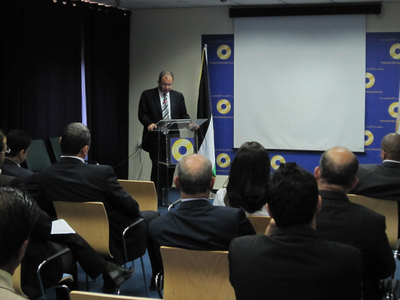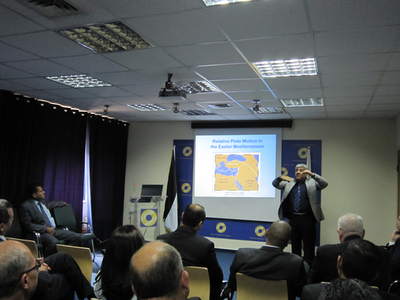The Urban Planning and Disaster Risk Reduction Center at An-Najah University Participates in a Seminar on the Strategic Planning for the Reduction of Disasters Risks
The Urban Planning and Disaster Risk Reduction Center at An-Najah University participated in a seminar on the strategic planning for the reduction of disasters risks which was held at the Palestine Monetary Authority headquarters in Ramallah. The seminar aimed to raise awareness with respect to risk, maintaining work on the level of the banking system, reinforce communication and coordination between the workers in the field of business continuity at the Monetary Authority, banks and the active institutions.

Attendees included workers in the field of business continuity at the Monetary Authority and banks, as well as Dr. Jalal Dabbeek, Director of the Urban Planning and Disaster Risk Reduction Center, Coordinator of the Scientific Centers at An-Najah, and the Vice President of the National Agency for Disaster Risk Mitigation in Palestine.
In his opening speech, Dr. Jihad Khalil Al-Wazeer, Governor of Palestine Monetary Authority, addressed the importance of setting strategic plans for risk management and reduction. He also called for establishing cooperation and coordination between the workers in this field to develop the capabilities of the banking system to effectively deal with the different types of disasters. Moreover, he explained that a special unit named Business Continuity Unit has been established at the Monetary Authority which will work on the issues related to the work of the banking system.

The lectures presented by Dr, Dabbeek addressed a variety of issues including: The level of risks and the mutual relationship between development and investment on one side and disasters on the other. Other issues included: The relationship between risks and sustainable development, the concept of disaster risk reduction, risk assessment and management, the basic concepts in the strategic planning for the reduction of disasters’ risks, how to enable cities to be resilient to disasters and how to make your city ready, earthquakes and the reasons behind them, how and why tsunamis occur, the seismic hazard in Palestine, the seismic performance and vulnerability of common buildings in Palestine, the most important international requirements and regulations for the building of nations’ and communities’ resilience to disasters according to the United Nations International Strategy for Disaster Reduction (UNISDR), the Hyogo Framework for Action 2005-2015, and the Arab Strategy for Disaster Risk Reduction 2011-2020.
Dr. Dabbeek also spoke about the impact of disasters on the constructions, economy and development in Palestine and the devastating effects various types of disasters can have on the country. He also pointed out the importance to set extensive national plans in which the public and private sectors as well as the local institutions participate to face such challenges.
It is important to raise the public awareness regarding strategic planning for the reduction of disaster risks. Dr. Dabbeek also reviewed the types of earthquakes, their impacts, how to deal with them, the seismic history of Palestine, the epicenter of expected earthquakes and their distribution in the region, the possibility for a major earthquake to take place in Palestine in the future, as well as the level of preparation in this regard.
Finally, Dr. Dabbeek stressed the necessity to set laws and regulations and design suitable mechanisms in order to establish an infrastructure that is resilient to disasters and able to survive them.



